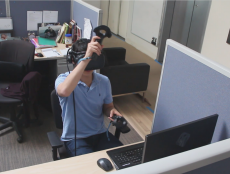
Articles
Editor’s Picks
Researchers Propose Mobile Apps as a Means to Spread Climate Change Awareness
By Henry Kronk
December 02, 2019
Climate change currently represents the greatest threat to society. Combatting it may stand as our generation’s most difficult challenge. While the solution will ultimately involve energy technology that does not rely on carbon, we still have a long way to go before we get there. Many scientists still struggle today to simply articulate and communicate the threat planet earth faces. In a recent article, researchers propose mobile apps, like Global Change, as an important tool one can use to fight ignorance and misinformation.
Many current democratic presidential candidates have discussed taking strong action to fight climate change. There are rumblings that the GOP may soon consider similar initiatives.
The Current State of Climate Change Awareness
Americans at large have also begun to come around to reality. A Washington Post and Kaiser Family Foundation poll in September found eight out ten surveyed believed climate change was real and caused, at least in part, by humans.
But only around half believe that the country needs to act quickly and swiftly to deal with it. Only four in ten consider climate change a crisis.
These numbers are all climbing, but there still remains a significant gap between the scientific community’s understanding of climate change and public opinion.
What’s more, a 2016 study found that most teachers echo the opinion of scientists that climate change has been caused primarily by human activity. But 31% of those surveyed also left open the possibility that the harsh climate events the earth is currently experiencing could be naturally occurring.
As researchers Sebastian Leuzinger (Auckland University of Technology), Stephanie Borrelle (University of Toronto), and Rebecca Jarvis (Sydney Institute of Marine Science) argue in a recent article, the communication of scientific findings is crucial.
“The most convincing scientific evidence is in vain if scientists fail to communicate key facts to policy makers or to the general public,” they write.
In their article, the researcher identify a variety of communication methods and break them down into the categories of ‘snakes’ (ineffective or detrimental) and ‘ladders’ (promising opportunities).
For example, a good deal of attention has been paid to the effect scientists might have on Twitter.
Many scientists, because of their line of work, are not natural tweeters. But the platform gives them the opportunity to speak directly to citizens in an unfiltered manner.
Unfortunately, their discourse will mingle potentially with that of others who have set out to spread misinformation.
For example, the researchers quote a January 2019 tweet from U.S. President Donald Trump, which reads, “In the beautiful Midwest, windchill temperatures are reaching minus 60 degrees, the coldest ever recorded. In coming days, expected to get even colder. People can’t last outside even for minutes. What the hell is going on with Global Waming? Please come back fast, we need you!”
The tweet has been liked nearly 200,000 times and has 48,000 retweets.
The Snakes and Ladders of Mobile Apps
Many scientists simply don’t have the follower base or clout to disseminate their findings so widely. So while Twitter might present a ladder, it can easily turn into a snake as well.
On the other hand, the researchers have found greater promise with educational mobile apps.
Some of the researchers participated in the beta testing of the Global Change app.
As the authors write, “The concept of the app is based on distilling the most critical pieces of information in a very clear and concise way. Misinformation in climate science and other areas prone to widespread misconception often originates from relatively easy to debunk myths. Therefore, the app is designed as a compact and easy to navigate tool with an emphasis on conveying how processes are linked rather than describe processes in isolation.”
During the development period, the app makers surveyed a group of German high schoolers. Before learning with the app, they were presented with the statement “I can explain the effect of rising CO2 at the level of the plant.” Over 70% of them responded “tend to disagree.” However, after using the app for a period of one week, over 77% responded “tend to agree.”
These results are largely preliminary and beg further investigation.
Like Twitter, educational apps also present various snakes and ladders. While they appear to be effective in the classroom, there’s still a question of access. Much of the world still lacks a mobile device and/or sufficient internet connections to use them. But at the same time, they stand as a promising avenue through which to deliver vetted information.
Read the full article here.
Featured Image: Kelly Sikkema, Unsplash.









“Your style is so unique in comparison to other people I’ve read
stuff from. Thanks for posting when you have the opportunity,
Guess I will just bookmark this page.”